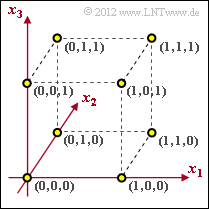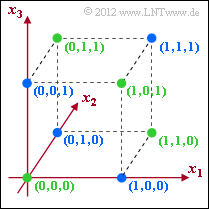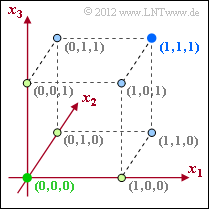Difference between revisions of "Aufgaben:Exercise 1.2Z: Three-dimensional Representation of Codes"
From LNTwww
| (One intermediate revision by the same user not shown) | |||
| Line 2: | Line 2: | ||
}} | }} | ||
| − | [[File:P_ID2400__KC_Z_1_2.png|right|frame|Space $\rm GF(2^3)$ and <br> | + | [[File:P_ID2400__KC_Z_1_2.png|right|frame|Space $\rm GF(2^3)$ and <br>code of length $n = 3$]] |
| − | Codes for error detection or error correction can be represented very clearly in $n$-dimensional space. We restrict ourselves here to binary codes of length $n = 3$: | + | Codes for error detection or error correction can be represented very clearly in an $n$-dimensional space. We restrict ourselves here to binary codes of length $n = 3$: |
| − | :$$\underline{x} = (x_{1}, x_{2}, x_{3}) \hspace{0.1cm} \in \hspace{0.1cm}{\rm GF}(2^3) \hspace{0.05cm},\hspace{0.5cm} x_i = \{0, 1 \}\hspace{0.05cm},\hspace{0.2cm} i = 1, 2, 3\hspace{0.05cm}.$$ | + | :$$\underline{x} = (x_{1},\ x_{2},\ x_{3}) \hspace{0.1cm} \in \hspace{0.1cm}{\rm GF}(2^3) \hspace{0.05cm},\hspace{0.5cm} x_i = \{0,\ 1 \}\hspace{0.05cm},\hspace{0.2cm} i = 1, 2, 3\hspace{0.05cm}.$$ |
| + | |||
| + | In general, for block coding: | ||
| + | *The information word $\underline{u} = (u_{1},\ u_{2}, \ \text{...} , \ u_{k})$ is uniquely transformed into the code word $\underline{x} =(x_{1},\ x_{2}, \ \text{...} , \ , x_{n})$. | ||
| − | |||
| − | |||
*The code rate is $R = k/n$. | *The code rate is $R = k/n$. | ||
| − | *The Hamming distance $d_{\rm H}(x, \hspace{0.05cm}x\hspace{0.05cm}')$ between two | + | |
| + | *The Hamming distance $d_{\rm H}(x, \hspace{0.05cm}x\hspace{0.05cm}')$ between two code words $x ∈ \mathcal{C}$ and $x\hspace{0.05cm}' ∈ \mathcal{C}$ indicates the number of bit positions in which $x$ and $x\hspace{0.05cm}'$ differ. | ||
| + | |||
*The minimum distance $d_{\rm min} = {\rm min}\big[d_{\rm H}(x, \hspace{0.05cm}x\hspace{0.05cm}')\big]$ is a measure of the correctability of a code. | *The minimum distance $d_{\rm min} = {\rm min}\big[d_{\rm H}(x, \hspace{0.05cm}x\hspace{0.05cm}')\big]$ is a measure of the correctability of a code. | ||
| − | |||
| − | |||
| + | *It can detect $e =d_{\rm min} - 1$ errors and can correct $t =(d_{\rm min} - 1)/2$ errors. | ||
| + | |||
| + | *The last statement, however, is valid only for odd $d_{\rm min}$. | ||
| + | Hints: | ||
| + | *This exercise belongs to the chapter [[Channel_Coding/Objective_of_Channel_Coding|"Objective of Channel Coding"]] | ||
| − | + | *In addition, some simple questions about the chapter [[Channel_Coding/Examples_of_Binary_Block_Codes|"Examples of binary block codes"]] are anticipated. | |
| − | * | ||
| − | |||
| Line 32: | Line 36: | ||
{Which statements hold if all points in $\rm GF(2^3)$ are occupied? | {Which statements hold if all points in $\rm GF(2^3)$ are occupied? | ||
|type="[]"} | |type="[]"} | ||
| − | + The assignment $\underline{u} = (u_{1}, u_{2}, u_{3})$ → $\underline{x} = (x_{1}, x_{2},x_{3})$ holds. | + | + The assignment $\underline{u} = (u_{1},\ u_{2},\ u_{3})$ → $\underline{x} = (x_{1},\ x_{2},\ x_{3})$ holds. |
| − | - The identity $\underline{x} = \underline{u}$ holds. | + | - The identity $\underline{x} = \underline{u}$ holds. |
+ The code rate is $R = 1$. | + The code rate is $R = 1$. | ||
| − | -The minimum distance between two | + | -The minimum distance between two code words is $d_{\rm min} = 2$. |
| − | {Which statements are true for a (3, 2, 2) | + | {Which statements are true for a $(3, 2, 2)$ block code? |
|type="[]"} | |type="[]"} | ||
| − | + | + | + Code $\mathcal{C}_{1} = \{(0, 0, 0),\ (0, 1, 1),\ (1, 0, 1),\ (1, 1, 0)\}$ is possible. |
| − | + Code $\mathcal{C}_{2} = \{(0, 0, 1), (0, 1, 0), (1, 0, 0), (1, 1, 1)\}$ is possible. | + | + Code $\mathcal{C}_{2} = \{(0, 0, 1),\ (0, 1, 0),\ (1, 0, 0),\ (1, 1, 1)\}$ is possible. |
| − | - Code $\mathcal{C}_{3} = \{(0, 0, 0), (0, 1, 1), (1, 0, 0), (1, 1, 1)\}$ is possible. | + | - Code $\mathcal{C}_{3} = \{(0, 0, 0),\ (0, 1, 1),\ (1, 0, 0),\ (1, 1, 1)\}$ is possible. |
| − | {What properties does the code defined in subtask '''(2)''' | + | {What properties does the code $\mathcal{C}_{1}$ defined in subtask '''(2)''' show? |
|type="[]"} | |type="[]"} | ||
+ A bit error can be detected. | + A bit error can be detected. | ||
- A bit error can be corrected. | - A bit error can be corrected. | ||
| − | {What properties does the code | + | {What properties does the code $\mathcal{C}_{4}= \{(0, 0, 0),\ (1, 1, 1)\}$ show? |
|type="[]"} | |type="[]"} | ||
- The code rate is $R = 1/4$. | - The code rate is $R = 1/4$. | ||
| Line 60: | Line 64: | ||
===Solution=== | ===Solution=== | ||
{{ML-Kopf}} | {{ML-Kopf}} | ||
| − | '''(1)''' Correct <u>statements 1 and 3</u>: | + | '''(1)''' Correct <u>statements 1 and 3</u>: |
| − | *In this assignment, $k = 3$ information bits are mapped to $n = 3$ code bits ⇒ $R = k/n = 1$. | + | *In this assignment, $k = 3$ information bits are mapped to $n = 3$ code bits ⇒ $R = k/n = 1$. |
| − | *The statement $\underline{x} = \underline{u} $ would only hold in the case of systematic coding. | + | *The statement $\underline{x} = \underline{u} $ would only hold in the case of systematic coding. |
| − | *For example, in principle | + | *For example, in principle. $(0, 0, 0)$ → $(0, 1, 1)$ would also be possible. |
| − | *The last statement is certainly false: | + | *The last statement is certainly false: From the graph one can see the minimum distance $d_{\rm min} = 1$. |
| − | [[File:P_ID2401__KC_Z_1_2b.png|right|frame|Two (3, 2, 2) block codes]] | + | [[File:P_ID2401__KC_Z_1_2b.png|right|frame|Two $(3, 2, 2)$ block codes]] |
| − | '''(2)''' Correct <u>statements 1 and | + | '''(2)''' Correct <u>statements 1 and 2</u>: |
| − | *$\mathcal{C}_{1}$ and $\mathcal{C}_{2}$ actually describe codes with rate $R = 2/3$ and minimum distance $d_{\rm min} = 2$. | + | *$\mathcal{C}_{1}$ and $\mathcal{C}_{2}$ actually describe codes with rate $R = 2/3$ and minimum distance $d_{\rm min} = 2$. |
| − | *In the graph, the green dots mark the code $\mathcal{C}_{1}$ and the blue dots mark the code $\mathcal{C}_{2}$. | + | *In the graph, the green dots mark the code $\mathcal{C}_{1}$ and the blue dots mark the code $\mathcal{C}_{2}$. |
| − | *For the code $\mathcal{C}_{3}$ | + | *For the code $\mathcal{C}_{3}$ – also with rate $R = 2/3$ – the minimum distance between two code words is $d_{\rm min} = 1$, <br>for example between $(0, 0, 0)$ and $(1, 0, 0)$ or between $(0, 1, 1)$ and $(1, 1, 1)$. |
| − | '''(3)''' Correct is only <u>statement 1</u>: | + | '''(3)''' Correct is only <u>statement 1</u>: |
| − | *Only a bit error can be detected with the minimum distance $d_{\rm min} = 2$. | + | *Only a bit error can be detected with the minimum distance $d_{\rm min} = 2$. |
| − | *In the upper graph, the green dots indicate allowed | + | *In the upper graph, the green dots indicate allowed code words of $\mathcal{C}_{1}$. <br>If a blue dot is received, this indicates a transmission error. |
| − | *On the other hand, error correction is not possible with $d_{\rm min} = 2$. | + | *On the other hand, error correction is not possible with $d_{\rm min} = 2$. |
| − | *The code $\mathcal{C}_{1}$ corresponds to the [[Channel_Coding/Examples_of_Binary_Block_Codes#Single_Parity_Check_Codes| | + | *The code $\mathcal{C}_{1}$ corresponds to the [[Channel_Coding/Examples_of_Binary_Block_Codes#Single_Parity_Check_Codes|single parity-check code $(3, 2, 2)$]]. |
| − | [[File:P_ID2402__KC_Z_1_2d.png|right|frame|(3, 1, 3) block code]] | + | [[File:P_ID2402__KC_Z_1_2d.png|right|frame|$(3, 1, 3)$ block code]] |
| − | '''(4)''' Correct <u>answers 2, 3, and 4</u>: | + | '''(4)''' Correct <u>answers 2, 3, and 4</u>: |
| − | *$C_{4}$ describes the [[Channel_Coding/Examples_of_Binary_Block_Codes#Repetition_Codes|(3, 1, 3) repetition code]]. | + | *$C_{4}$ describes the [[Channel_Coding/Examples_of_Binary_Block_Codes#Repetition_Codes|$(3, 1, 3)$ repetition code]]. In this code, two of the total eight possible points are occupied, from which one could incorrectly conclude the code rate $R = 1/4$. |
| − | + | *However, the code rate is calculated according to $R = k/n = 1/3$. | |
| − | *From the lower diagram one recognizes that because of $d_{\rm min} = 3$ now also | + | *From the lower diagram one recognizes that because of $d_{\rm min} = 3$ now also one bit error can be corrected. |
| − | *During decoding, all light green points (with black outline) are transferred to the green point $(0, 0, 0)$ and all light blue points are transferred to the blue point $(1, 1, 1)$. | + | *During decoding, all light green points (with black outline) are transferred to the green point $(0, 0, 0)$ and all light blue points are transferred to the blue point $(1, 1, 1)$. |
| − | *Up to two bit errors can be detected at the same time (one of course). | + | *Up to two bit errors can be detected at the same time (one of course). |
{{ML-Fuß}} | {{ML-Fuß}} | ||
Latest revision as of 14:23, 6 June 2022
Codes for error detection or error correction can be represented very clearly in an $n$-dimensional space. We restrict ourselves here to binary codes of length $n = 3$:
- $$\underline{x} = (x_{1},\ x_{2},\ x_{3}) \hspace{0.1cm} \in \hspace{0.1cm}{\rm GF}(2^3) \hspace{0.05cm},\hspace{0.5cm} x_i = \{0,\ 1 \}\hspace{0.05cm},\hspace{0.2cm} i = 1, 2, 3\hspace{0.05cm}.$$
In general, for block coding:
- The information word $\underline{u} = (u_{1},\ u_{2}, \ \text{...} , \ u_{k})$ is uniquely transformed into the code word $\underline{x} =(x_{1},\ x_{2}, \ \text{...} , \ , x_{n})$.
- The code rate is $R = k/n$.
- The Hamming distance $d_{\rm H}(x, \hspace{0.05cm}x\hspace{0.05cm}')$ between two code words $x ∈ \mathcal{C}$ and $x\hspace{0.05cm}' ∈ \mathcal{C}$ indicates the number of bit positions in which $x$ and $x\hspace{0.05cm}'$ differ.
- The minimum distance $d_{\rm min} = {\rm min}\big[d_{\rm H}(x, \hspace{0.05cm}x\hspace{0.05cm}')\big]$ is a measure of the correctability of a code.
- It can detect $e =d_{\rm min} - 1$ errors and can correct $t =(d_{\rm min} - 1)/2$ errors.
- The last statement, however, is valid only for odd $d_{\rm min}$.
Hints:
- This exercise belongs to the chapter "Objective of Channel Coding"
- In addition, some simple questions about the chapter "Examples of binary block codes" are anticipated.
Questions
Solution
(1) Correct statements 1 and 3:
- In this assignment, $k = 3$ information bits are mapped to $n = 3$ code bits ⇒ $R = k/n = 1$.
- The statement $\underline{x} = \underline{u} $ would only hold in the case of systematic coding.
- For example, in principle. $(0, 0, 0)$ → $(0, 1, 1)$ would also be possible.
- The last statement is certainly false: From the graph one can see the minimum distance $d_{\rm min} = 1$.
(2) Correct statements 1 and 2:
- $\mathcal{C}_{1}$ and $\mathcal{C}_{2}$ actually describe codes with rate $R = 2/3$ and minimum distance $d_{\rm min} = 2$.
- In the graph, the green dots mark the code $\mathcal{C}_{1}$ and the blue dots mark the code $\mathcal{C}_{2}$.
- For the code $\mathcal{C}_{3}$ – also with rate $R = 2/3$ – the minimum distance between two code words is $d_{\rm min} = 1$,
for example between $(0, 0, 0)$ and $(1, 0, 0)$ or between $(0, 1, 1)$ and $(1, 1, 1)$.
(3) Correct is only statement 1:
- Only a bit error can be detected with the minimum distance $d_{\rm min} = 2$.
- In the upper graph, the green dots indicate allowed code words of $\mathcal{C}_{1}$.
If a blue dot is received, this indicates a transmission error. - On the other hand, error correction is not possible with $d_{\rm min} = 2$.
- The code $\mathcal{C}_{1}$ corresponds to the single parity-check code $(3, 2, 2)$.
(4) Correct answers 2, 3, and 4:
- $C_{4}$ describes the $(3, 1, 3)$ repetition code. In this code, two of the total eight possible points are occupied, from which one could incorrectly conclude the code rate $R = 1/4$.
- However, the code rate is calculated according to $R = k/n = 1/3$.
- From the lower diagram one recognizes that because of $d_{\rm min} = 3$ now also one bit error can be corrected.
- During decoding, all light green points (with black outline) are transferred to the green point $(0, 0, 0)$ and all light blue points are transferred to the blue point $(1, 1, 1)$.
- Up to two bit errors can be detected at the same time (one of course).


